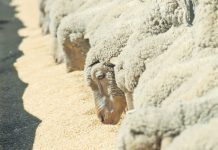Columbia University researchers have developed an affordable forensic dating tool that will help to track illegal ivory. Almost 25 years after an international ban was placed on ivory trade, African elephants are still being slaughtered at a rate that could bring about their extinction this century.
By allowing the trade on ivory acquired before 1989 to continue, the ban put an impossible burden on law enforcement to distinguish between legal and poached ivory. “We’ve developed a tool that allows us to determine the age of a tusk or piece of ivory,” says study author Kevin Uno, a postdoctoral researcher at Columbia University’s Lamont-Doherty Earth Observatory.
The new method, described in the latest issue of the Proceedings of the National Academy of Sciences, could also be applied to rhino and other wildlife. Elephant tusks show a link between diet and global radioactivity, which gives scientists a time marker. Plants absorb radiocarbon put into the air by nuclear weapons testing in the 1950s and 1960s. The radiocarbon travels up the food chain, finding its way into the fingernails, hair, teeth and tusks of animals.
By comparing radiocarbon levels in those tissues against the fluctuating “bomb curve” of radiocarbon in the atmosphere, forensic scientists can pinpoint when the tissues formed, and in some cases, when the animal died. Columbia researchers used tusks from two elephants and measured radiocarbon levels at the base of each tusk to calculate when the elephants died. Similar tests were performed on monkey hair, hippo canines, oryx horn and elephant tail hairs to verify that the method worked across tissues of different ages.
Meanwhile, researchers at the University of Washington’s Centre for Conservation Biology laid out a map of African elephant populations based on DNA from their dung. When matched against a piece of seized ivory, the dung could tell investigators where the ivory originated, said director Sam Wasser.
Thus, the DNA tool has helped law enforcement identify where elephants are being poached, while the new radiocarbon tool tells them when. Elephant poaching is at its highest level since record-keeping began in 2002 and more elephants are slaughtered today — 30 000 a year – than before the 1989 ban. The IUCN’s elephant database shows that only 423 000 of African elephants remain.
Much illegal ivory leaves Africa through Tanzania and Kenya and goes to Asia, where it is carved into religious icons and decorative art popular with the Chinese and Japanese. China imports about 70% of the smuggled ivory.












